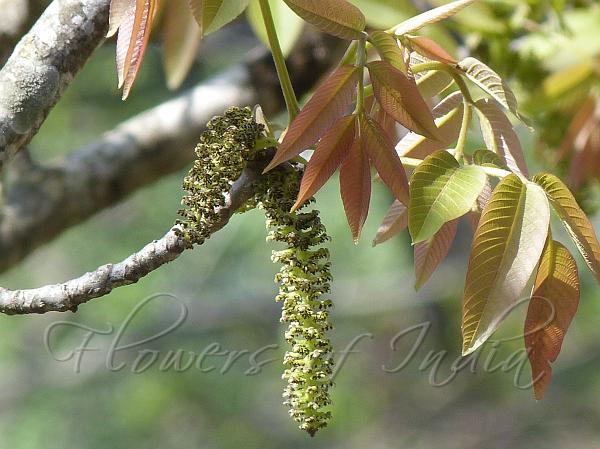|
| Walnut |
|

|

| File size | 773454 |
| Original date | 4/6/12 3:22 PM |
| Resolution | 2560 x 1920 |
| Flash | Flash did not fire, auto |
| Focal length | 108.0mm |
| Exposure time | 1/125s |
| Aperture | 5.2 |
| Focus Distance | |
| Metering Mode | Multi-segment |
| Camera make | Panasonic |
| Camera model | DMC-FZ40 |
| Sensor type | OneChipColorArea |
|
|
|
|
Photo: |
Botanical name: Juglans regia Family: Juglandaceae (Walnut family)
Synonyms: Juglans kamaonia, Juglans orientis, Juglans fallax
Synonyms: Juglans kamaonia, Juglans orientis, Juglans fallax
Walnut is a large, deciduous tree attaining heights
of 25-35 m, and a trunk up to 2 m diameter, commonly with a short trunk
and broad crown, though taller and narrower in dense forest
competition. The bark is smooth, olive-brown when young and
silvery-grey on older branches, and features scattered broad fissures
with a rougher texture. Like all walnuts, the pith of the twigs
contains air spaces; this chambered pith is brownish in color. The
leaves are alternately arranged, 25-40 cm long, odd-pinnate with 5-9
leaflets, paired alternately with one at branch-ends leaflet. The
largest leaflets are the three at the tip, 10-18 cm long and 6-8 cm
broad; the basal pair of leaflets are much smaller, 5-8 cm long, with
the margins of the leaflets entire. The male flowers are in drooping
catkins 5-10 cm long, and the female flowers are at branch-ends, in
clusters of two to five, ripening in the autumn into a fruit with a
green, semi-fleshy husk and a brown, corrugated nut. The whole fruit,
including the husk, falls in autumn; the seed is large, with a
relatively thin shell, and edible, with a rich flavour. Walnut is found
in West Asia, W. China and the Himalayas, at altitudes of 1000-3300 m.
| Identification credit: Anil Thakur | Photographed in Dhanaulti, Uttarakhand & Shimla, Himachal Pradesh. |
• Is this flower misidentified? If yes,